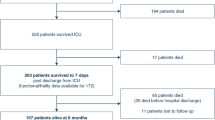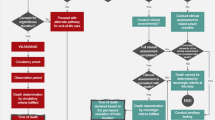Abstract
Background
Organ shortage is the greatest challenge facing the field of organ transplantation today. Use of more organs of marginal quality has been advocated to address the shortage.
Method
We examined the pattern of donation and organ use in the United States as shown in the Organ Procurement and Transplantation Network/United Network for Organ Sharing database of individuals who were consented for and progressed to organ donation between January 2001 and December 2010.
Results
There were 66,421 living donors and 73,359 deceased donors, including 67,583 (92.1 %) identified as donation after brain death and 5,776 (7.9 %) as donation after circulatory death (DCD). Comparing two periods, era 1 (01/2001–12/2005) and era 2 (01/2006–12/2010), the number of deceased donors increased by 20.3 % from 33,300 to 40,059 while there was a trend for decreasing living donation. The DCD subgroup increased from 4.9 to 11.7 % comparing the two eras. A significant increase in cardiovascular/cerebrovascular disease as a cause of death was also noted, from 38.1 % in era 1 to 56.1 % in era 2 (p < 0.001), as was a corresponding decrease in the number of deaths due to head trauma (48.8 vs. 34.9 %). The overall discard rate also increased from 13,411 (11.5 %) in era 1 to 19,516 (13.7 %) in era 2. This increase in discards was especially prominent in the DCD group [440 (20.9 %) in era 1 vs. 2,089 (24.9 %) in era 2].
Conclusions
We detect a significant change in pattern of organ donation and use in the last decade in the United States. The transplant community should consider every precaution to prevent the decay of organ quality and to improve the use of marginal organs.

Similar content being viewed by others
Abbreviations
- DBD:
-
Donation after brain death
- DCD:
-
Donation after circulatory death
- OPTN:
-
Organ Procurement and Transplantation Network
- UNOS:
-
United Network for Organ Sharing
- ECD:
-
Expanded criteria donor
- SCD:
-
Standard criteria donor
- HRSA:
-
Health Resources and Services Administration
- CVA:
-
Cerebrovascular accident
- DSA:
-
Donation service areas
References
Annual Report of the U.S. Organ Procurement and Transplantation Network and the Scientific Registry of Transplant Recipients: transplant data 1999–2008 (2009) Department of Health and Human Services, Health Resources and Services Administration, Healthcare Systems Bureau, Division of Transplantation, Rockville
Klein AS, Messersmith EE, Ratner LE et al (2010) Organ donation and utilization in the United States, 1999–2008. Am J Transplant 10(4 Pt 2):973–986
Howard RJ, Schold JD, Cornell DL (2005) A 10-year analysis of organ donation after cardiac death in the United States. Transplantation 80:564–568
Bernat JL, D’Alessandro AM, Port FK et al (2006) Report of a National Conference on Donation after cardiac death. Am J Transplant 6:281–291
Tuttle-Newhall JE, Krishnan SM, Levy MF et al. (2009) Organ donation and utilization in the United States, 1998–2007. Am J Transplant (4 Pt 2):879–893. www.unos.gov. Accessed 25 Dec 2011
Merion RM, Ashby VB, Wolfe RA et al (2005) Deceased-donor characteristics and the survival benefit of kidney transplantation. J Am Med Assoc 294:2726–2733
McCullough KP, Keith DS, Meyer KH et al (2009) Kidney and pancreas transplantation in the United States, 1998–2007. Am J Transplant 9(4 Pt 2):894–906
Matesanz R, Marazuela R, Domínguez-Gil B et al (2009) The 40 donors per million population plan: an action plan for improvement of organ donation and transplantation in Spain. Transplant Proc 41:3453–3456
Oliver M, Woywodt A, Ahmed A et al (2011) Organ donation, transplantation and religion. Nephrol Dial Transplant 26:437–444
Vagefi PA, Ascher NL, Freise CE et al (2012) Use of living donor liver transplantation varies with the availability of deceased donor liver transplantation. Liver Transplant 18:160–165
Marks WH, Wagner D, Pearson TC et al (2006) Organ donation and utilization, 1995–2004: entering the collaborative era. Am J Transplant 6:1101–1110
Howard RJ, Schold JD, Cornell DL (2005) A 10-year analysis of organ donation after cardiac death in the United States. Transplantation 80:564–568
Saidi RF, Bradley J, Greer D et al (2010) Changing pattern of organ donation at a single center; are potential brain dead donors being lost to donation after cardiac death? Am J Transplant 10:2536–2540
Feng S, Goodrich NP, Bragg-Gresham JL et al (2006) Characteristics associated with liver graft failure: the concept of a donor risk index. Am J Transplant 6:783–790
Merion RM, Pelletier SJ, Goodrich N et al (2006) Donation after cardiac death as a strategy to increase deceased donor liver availability. Ann Surg 244:555–562
Saidi RF, Elias N, Kawai T et al (2007) Outcome of kidney transplantation using expanded criteria donors and donation after cardiac death kidneys: realities and costs. Am J Transplant 7:2769–2774
Axelrod DA, Schnitzler M, Salvalaggio PR et al (2007) The economic impact of the utilization of liver allografts with high donor risk index. Am J Transplant 7:990–997
Boucek MM, Mashburn C, Dunn SM et al (2008) Pediatric heart transplantation after declaration of cardiocirculatory death. N Engl J Med 359:709–714
Farney AC, Singh RP, Hines MH et al (2008) Experience in renal and extrarenal transplantation with donation after cardiac death donors with selective use of extracorporeal support. J Am Coll Surg 206:1028–1037
Moers C, Smits JM, Maathuis MH et al (2009) Machine perfusion or cold storage in deceased-donor kidney transplantation. N Engl J Med 360:7–19
Fondevila C (2010) Is extracorporeal support becoming the new standard for the preservation of DCD grafts? Am J Transplant 10:1341–1342
Conflict of interest
None.
Author information
Authors and Affiliations
Corresponding author
Rights and permissions
About this article
Cite this article
Saidi, R.F., Markmann, J.F., Jabbour, N. et al. The Faltering Solid Organ Donor Pool in the United States (2001–2010). World J Surg 36, 2909–2913 (2012). https://doi.org/10.1007/s00268-012-1748-0
Published:
Issue Date:
DOI: https://doi.org/10.1007/s00268-012-1748-0




